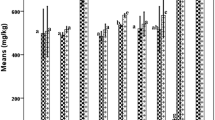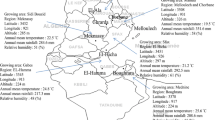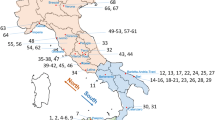Abstract
The aim of this work was to characterize extra virgin olive oils (EVOOs) from four cultivars (Arbequina, Chétoui, Neb Jmal and Picholine) cultivated in Northern Tunisia (Borj El Amri) in terms of their phenolic profile. Determination of total phenol content was first performed spectrophotometrically using the Folin–Ciocalteu reagent. The total phenol content of the analyzed EVOOs varied from 77.33 mg GAE kg−1 in ‘Arbequina’ oil to 405 mg GAE kg−1 in ‘Picholine’ oil. Moreover, the polar extracts were analyzed by a rapid and effective Rapid-resolution liquid chromatography coupled to electrospray ionization time-of-flight mass spectrometry (RRLC–ESI-TOF/MS) method, and 48 phenolic compounds belonging to different classes were identified. The results showed significantly quantitative differences observed for all phenolic compounds except for oleuropein that was present only in two cultivars. In all olive oil samples studied, secoiridoids were the most abundant. Deacetoxyoleuropeinaglycone remains the most abundant complex phenol in Picholine (250.39 mg kg−1), Neb Jmal (104.34 mg kg−1) and Arbequina (19.93 mg kg−1) EVOOs, while in Chétoui oil, the oleuropeinaglycone isomer 5 content is the highest with mean value of 381.63 mg kg−1. The application of principal component analysis permitted a good classification of the EVOOs according to their phenolic profiles.



Similar content being viewed by others
References
Boskou D, Tsimidou M, Blekas G (2006) Polar phenolic compounds. In: Boskou D (ed) Olive oil: chemistry and technology, 2nd edn. AOCS, Illinois, pp 73–92
International Olive Council (2014) http://www.internationaloliveoil.org/estaticos/view/131-world-olive-oil-figures. www.internationaloliveoil.org. Accessed 20 Dec 2014
Office national de l’huile (2015) Olive tree in Tunisia. www.onh.com.tn. Accessed 5 Nov 2015
Baiano A, Terracone C, Viggiani I, Del Nobile MA (2013) Effects of cultivars and location on quality, phenolic content and antioxidant activity of extra-virgin olive oils. JAOCS J Am Oil Chem Soc 90:103–111
Tura D, Gigliotti C, Pedò S et al (2007) Influence of cultivar and site of cultivation on levels of lipophilic and hydrophilic antioxidants in virgin olive oils (Olea Europea L.) and correlations with oxidative stability. Sci Hortic (Amsterdam) 112:108–119
Owen RW, Giacosa A, Hull WE et al (2000) The antioxidant/anticancer potential of phenolic compounds isolated from olive oil. Eur J Cancer 36:1235–1247
Cicerale S, Lucas L, Keast R (2010) Biological activities of phenolic compounds present in virgin olive oil. Int J Mol Sci 11:458–479
García-Villalba R, Carrasco-Pancorbo A, Oliveras-Ferraros C et al (2010) Characterization and quantification of phenolic compounds of extra-virgin olive oils with anticancer properties by a rapid and resolutive LC-ESI-TOF MS method. J Pharm Biomed Anal 51:416–429
Gutierrez-Rosales F, Rios JJ, Gomez-Rey ML (2003) Main polyphenols in the bitter taste of virgin olive oil-Structural confirmation by on-line high-performance liquid chromatography electrospray ionization mass spectrometry. J Agric Food Chem 51:6021–6025
Bendini A, Cerretani L, Carrasco-Pancorbo A et al (2007) Phenolic molecules in virgin olive oils: a survey of their sensory properties, health effects, antioxidant activity and analytical methods. An overview of the last decade. Molecules 12:1679–1719
Fu S, Segura-Carretero A, Arráez-Román D et al (2009) Tentative characterization of novel phenolic compounds in extra virgin olive oils by rapid-resolution liquid chromatography coupled with mass spectrometry. J Agric Food Chem 57:11140–11147
Servili M, Esposto S, Fabiani R et al (2009) Phenolic compounds in olive oil: antioxidant, health and organoleptic activities according to their chemical structure. Inflammopharmacology 17(76–84):13
Morelló JR, Motilva MJ, Tovar MJ, Romero MP (2004) Changes in commercial virgin olive oil (cv Arbequina) during storage, with special emphasis on the phenolic fraction. Food Chem 85:357–364
Dabbou S, Issaoui M, Servili M et al (2009) Characterisation of virgin olive oils from European olive cultivars introduced in Tunisia. Eur J Lipid Sci Technol 111:392–401
Guerfel M, Ouni Y, Taamalli A et al (2009) Effect of location on virgin olive oils of the two main Tunisian olive cultivars. Eur J Lipid Sci Technol 111:926–932
Ballus CA, Quirantes-Piné R, Bakhouche A et al (2015) Profile of phenolic compounds of Brazilian virgin olive oils by rapid resolution liquid chromatography coupled to electrospray ionisation time-of-flight mass spectrometry (RRLC–ESI–TOF–MS). Food Chem 170:366–377
El Riachy M, Priego-Capote F, Rallo L et al (2012) Phenolic profile of virgin olive oil from advanced breeding selections. Span J Agric Res 10:443–453
Morello J-R, Romero M-P, Motilva M-J (2004) Effect of the maturation process of the olive fruit on the phenolic fraction of drupes and oils from arbequina, farga, and morrut Cultivars. J Agric Food Chem 52:6002–6009
Aparicio R, Luna G (2002) Characterisation of monovarietal virgin olive oils. Eur J Lipid Sci Technol 104:614–627
Bengana M, Bakhouche A, Lozano-Sánchez J et al (2013) Influence of olive ripeness on chemical properties and phenolic composition of Chemlal extra-virgin olive oil. Food Res Int 54:1868–1875
Bakhouche A, Lozano-Sánchez J, Beltrán-Debón R et al (2013) Phenolic characterization and geographical classification of commercial Arbequina extra-virgin olive oils produced in southern Catalonia. Food Res Int 50:401–408
Lerma-García MJ, Lantano C, Chiavaro E et al (2009) Classification of extra virgin olive oils according to their geographical origin using phenolic compound profiles obtained by capillary electrochromatography. Food Res Int 42:1446–1452
OuniY O, Flamini G, Daoud D, Zarrouk M (2011) Effect of cultivar on minor components in Tunisia olive fruits cultivated in microclimate. J Hortic For 3:13–20
Bajoub A, Carrasco-Pancorbo A, Ajal EA, et al. (2015) Potential of LC-MS phenolic profiling combined with multivariate analysis as an approach for the determination of the geographical origin of north Moroccan virgin olive oils. Food Chem 166:292–300
Conseil oleicole International (2011) Guide pour la determination des caractéristiques des olives à huile. COI/OH/Doc, no 1, pp 1–34
Papoti VT, Tsimidou MZ (2009) Looking through the qualities of a fluorimetric assay for the total phenol content estimation in virgin olive oil, olive fruit or leaf polar extract. Food Chem 112:246–252
Kalantzakis G, Blekas G, Pegklidou K, Boskou D (2006) Stability and radical-scavenging activity of heated olive oil and other vegetable oils. Eur J Lipid Sci Technol 108:329–335
Lozano-Sánchez J, Segura-Carretero A, Menendez JA et al (2010) Prediction of extra virgin olive oil varieties through their phenolic profile. Potential cytotoxic activity against human breast cancer cells. J Agric Food Chem 58:9942–9955
Rotondi A, Bendini A, Cerretani L et al (2004) Effect of olive ripening degree on the oxidative stability and organoleptic properties of cv. Nostrana di Brisighella extra virgin olive oil. J Agric Food Chem 52:3649–3654
Haddada FM, Krichène D, Manai H et al (2008) Analytical evaluation of six monovarietal virgin olive oils from Northern Tunisia. Eur J Lipid Sci Technol 110:905–913
Krichene D, Taamalli W, Daoud D et al (2006) Minor components in virgin olive oils of some Tunisian varieties. J Food Biochem 31:179–194
Chtourou M, Gargouri B, Jaber H et al (2013) Comparative study of olive oil quality from Chemlali Sfax versus Arbequina cultivated in Tunisia. Eur J Lipid Sci Technol 115:631–640
Guerfel M, Ben Mansour M, Ouni Y et al (2012) Compositional quality of virgin olive oils from cultivars introduced in two Tunisian locations. African J Agric Reseearch 7:2469–2474
Taamalli A, Gómez-Caravaca AM, Zarrouk M et al (2010) Determination of apolar and minor polar compounds and other chemical parameters for the discrimination of six different varieties of Tunisian extra-virgin olive oil cultivated in their traditional growing area. Eur Food Res Technol 231:965–975
Tripoli E, Giammanco M, Tabacchi G et al (2005) The phenolic compounds of olive oil: structure, biological activity and beneficial effects on human health. Nutr Res Rev 18:98–112
Warleta F, Quesada CS, Campos M et al (2011) Hydroxytyrosol protects against oxidative DNA damage in human breast cells. Nutrients 3:839–857
Efsa, NDA Panel (2011) Scientific Opinion on the substantiation of health claims related to polyphenols in olive and protection of LDL particles from oxidative damage. Efsa J 9:1–25
Perri E, Raffaelli A, Sindona G (1999) Quantitation of oleuropein in virgin olive oil by ionspray mass spectrometry-selected reaction monitoring. J Agric Food Chem 47:4156–4160
De Nino A, Di Donna L, Mazzotti F et al (2005) Absolute method for the assay of oleuropein in olive oils by atmospheric pressure chemical ionization tandem mass spectrometry. Anal Chem 77:5961–5964
Di Giovacchino L, Sestili S (2002) Influence of olive processing on virgin olive oil quality. Eur J Lipid Sci Tech 104:587–601
Visioli F, Galli C (1998) Olive oil phenols and their potential effects on human health. J Agric Food Chem 46:4292–4296
Bisignano G, Tomaino A, Lo Cascio R et al (1999) On the in vitro antimicrobial activity of oleuropein and hydroxytyrosol. J Pharm Pharmacol 51:971–974
Allalout A, Krichène D, Methenni K et al (2009) Characterization of virgin olive oil from super intensive Spanish and Greek varieties grown in northern Tunisia. Sci Hortic (Amsterdam) 120:77–78
Sánchez de Medina V, Priego-Capote F, de Castro MDL (2015) Characterization of monovarietal virgin olive oils by phenols profiling. Talanta 132:424–432
Abaza L, Taamalli W, Ben Temime S et al (2005) Natural antioxidant composition as correlated to stability of some Tunisian virgin olive oils. La Riv Ital delle Sostanze Grasse LXXXII:12–18
Huri I, Beraat O, Vera VH, Roland V (2010) Characterization of aegean olive oils by their minor compounds. JAOCS, J Am Oil Chem Soc 87:627–636
Ouni Y, Flamini G, Issaoui M et al (2011) Volatile compounds and compositional quality of virgin olive oil from Oueslati variety: influence of geographical origin. Food Chem 124:1770–1776
Taamalli A, Arráez Román D, Zarrouk M et al (2012) Classification of “Chemlali” accessions according to the geographical area using chemometric methods of phenolic profiles analysed by HPLC-ESI-TOF-MS. Food Chem 132:561–566
Ouni Y, Taamalli A, Gómez-Caravaca AM et al (2011) Characterisation and quantification of phenolic compounds of extra-virgin olive oils according to their geographical origin by a rapid and resolutive LC-ESI-TOF MS method. Food Chem 127:1263–1267
Owen RW, Mier W, Giacosa A et al (2000) Identification of lignans as major components in the phenolic fraction of olive oil. Clin Chem 46:976–988
Brenes M, García A, Rios JJ et al (2002) Use of 1-acetoxypinoresinol to authenticate Picual olive oils. Int J Food Sci Technol 37:615–625
Ben Hassine K, Taamalli A, Ben Slama M et al (2015) Characterization and preference mapping of autochthonous and introduced olive oil cultivars in Tunisia. Eur J Lipid Sci Technol 117:112–121
Arslan D, Schreiner M (2012) Chemical characteristics and antioxidant activity of olive oils from Turkish varieties grown in Hatay province. Sci Hortic (Amsterdam) 144:141–152
Acknowledgments
The authors are grateful to the Tunisian Ministry of Higher Education and Scientific Research for the financial support and to P10-FQM-6563 and P11-CTS-7625 (Andalusian Regional Government Council of Innovation and Science). A. Loubiri thanks Mr. K. Karoui for the English revision.
Author information
Authors and Affiliations
Corresponding author
Ethics declarations
Conflicts of interest
The authors declare no conflict of interest.
Rights and permissions
About this article
Cite this article
Loubiri, A., Taamalli, A., Talhaoui, N. et al. Usefulness of phenolic profile in the classification of extra virgin olive oils from autochthonous and introduced cultivars in Tunisia. Eur Food Res Technol 243, 467–479 (2017). https://doi.org/10.1007/s00217-016-2760-7
Received:
Revised:
Accepted:
Published:
Issue Date:
DOI: https://doi.org/10.1007/s00217-016-2760-7




